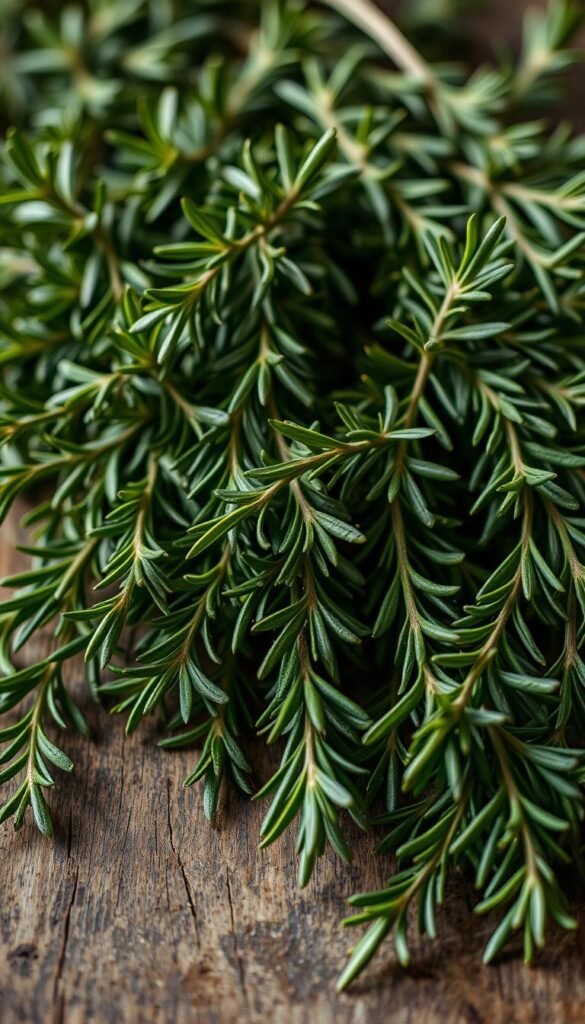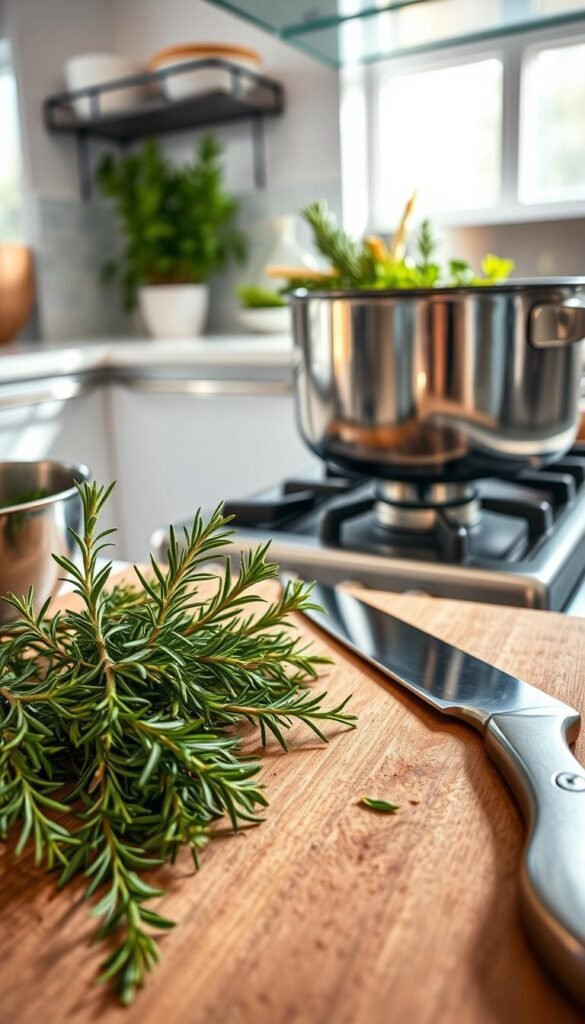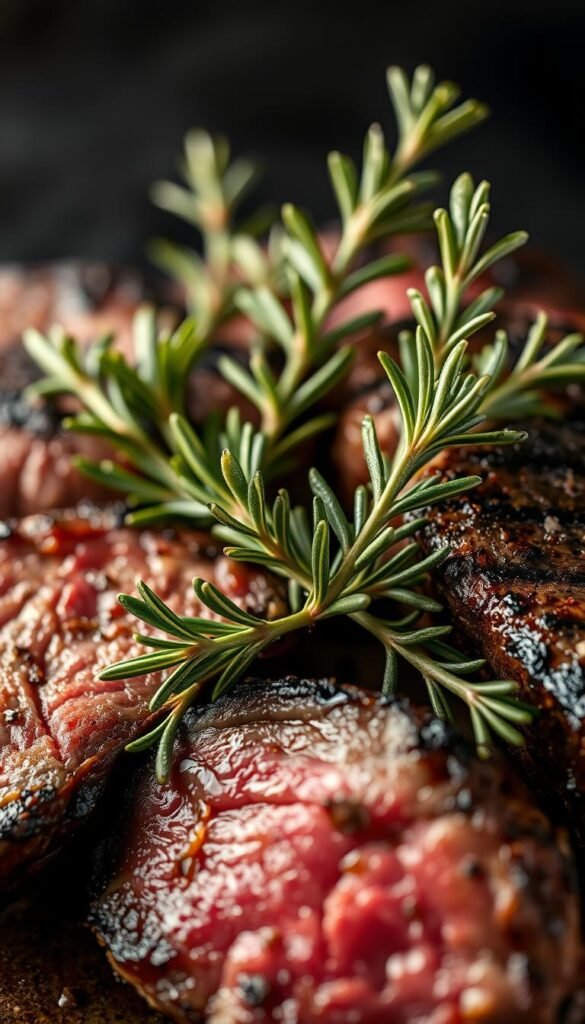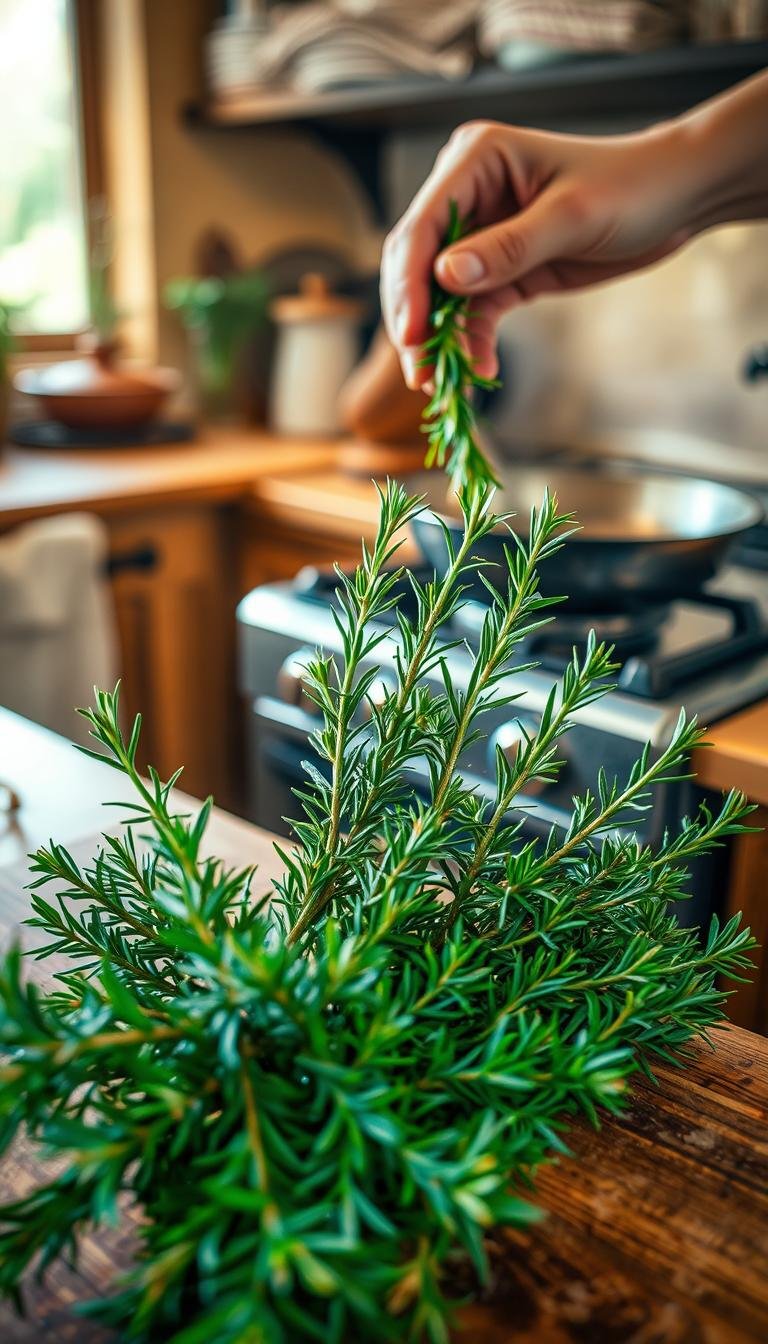13 Simple Ways to Cook with Fresh Rosemary
Did you know rosemary is super versatile in cooking? It’s not just for its pine-like taste. It also has lots of health benefits. Fresh rosemary makes many dishes better, like roasted meats and baked goods. It adds a special smell and taste.
This guide will show you how to use culinary herbs like rosemary. You’ll learn how to pick, store, and get ready rosemary. Plus, you’ll find tasty rosemary recipes to make your cooking better.
Key Takeaways
- Discover the versatility of fresh rosemary in various dishes.
- Learn how to properly select and store rosemary.
- Explore different rosemary recipes for everyday meals.
- Understand the health benefits associated with rosemary.
- Enhance your culinary skills with rosemary-based cooking techniques.
The Aromatic World of Fresh Rosemary
Fresh rosemary is a journey into the world of taste. It smells like pine and tastes amazing. It’s a key herb in Mediterranean cooking.
Rosemary’s strong flavor makes it great for cooking. It can handle high heat and long cooking times. This makes it perfect for roasting, grilling, and slow-cooking.
Culinary Properties of Rosemary
Rosemary has a strong, pine-like taste and smell. It has lots of essential oils, like camphor and cineole. These oils make it taste and smell unique.
When you cook rosemary, its flavor gets even stronger. It goes well with meats, veggies, and bread.
- Intensity: Rosemary is very flavorful, so use it sparingly.
- Oil Content: Its high oil content makes it very aromatic.
- Cooking Methods: Rosemary works well with roasting and grilling.
Health Benefits of Cooking with Rosemary
Cooking with rosemary adds flavor and health benefits. It’s full of antioxidants that fight stress and inflammation. It also has compounds that might help your brain and fight inflammation.
“Rosemary has been linked to better brain function and memory. Its antioxidants are good for your health.”
The health perks of rosemary include:
- Antioxidants to fight stress and inflammation
- Benefits for your brain, like memory improvement
- Anti-inflammatory effects for better health
Adding fresh rosemary to your meals boosts flavor and health. It’s a win-win for your taste buds and body.
Selecting and Storing Fresh Rosemary
Choosing the right rosemary is the first step in cooking. You can find it at stores, markets, or grow it yourself. The quality of your rosemary affects your dishes a lot.
Choosing the Best Rosemary
Look for sprigs with vibrant green needles and pliable stems. A strong, resinous scent means it’s fresh. Stay away from sprigs with brown spots or a weak smell.

Proper Storage for Maximum Freshness
After picking your rosemary, store it right to keep it fresh. Here are some ways:
- Wrap rosemary in damp paper towels and keep it in the fridge.
- Put rosemary sprigs in a jar of water like cut flowers and chill it.
- Freeze rosemary in olive oil using ice cube trays.
- Dry rosemary by hanging it upside down in a warm, dry spot.
| Storage Method | Duration | Notes |
|---|---|---|
| Refrigeration | 1-2 weeks | Check regularly for signs of drying out. |
| Freezing in Olive Oil | Up to 6 months | Ideal for cooked dishes. |
| Drying | Up to 1 year | Store in airtight containers. |
By picking the best rosemary and storing it well, you can enjoy its flavor and smell for months.
Preparing Rosemary for Different Cooking Methods
To get the most flavor from rosemary, you need to prepare it right. There are a few easy steps to follow. These steps can really improve your cooking.
Stripping and Chopping Rosemary Leaves
Removing rosemary leaves from stems is easy. Just hold the top of the sprig and pull down. This way, you get the leaves without any trouble.
For chopped rosemary, use a sharp knife. This helps avoid bruising the leaves. Rosemary can be hard to chop because of its resin. But, rinsing or dry chopping can make it easier.

It’s important to chop rosemary the right way. For soups or stews, a coarse chop works well. But, for baked goods or sauces, a finer chop is better. Try not to bruise the leaves too much. This can make the dish taste different.
When to Use Whole Sprigs vs. Chopped Leaves
Choosing between whole sprigs and chopped leaves depends on how you cook. Whole sprigs are great for slow-cooked dishes like roasts and stews. They let the herb infuse its flavor slowly.
On the other hand, chopped leaves are better for quick cooking. They give a stronger rosemary taste. This is good for grilled meats or vegetables.
| Cooking Method | Recommended Rosemary Form | Flavor Profile |
|---|---|---|
| Slow Cooking (Stews, Roasts) | Whole Sprigs | Mild, Infused |
| Quick Cooking (Grilled Meats, Vegetables) | Chopped Leaves | Pronounced, Fresh |
| Baked Goods, Sauces | Chopped Leaves | Distinct, Aromatic |
Knowing when to use whole sprigs or chopped leaves can make your dishes better. The stem of rosemary can taste bitter if not removed. So, chopped leaves are often a better choice for many recipes.
13 Simple Ways to Cook with Fresh Rosemary
Rosemary’s scent can make simple meals special. It’s a versatile herb for roasting, grilling, infusing, and baking. We’ll show you 13 easy ways to use rosemary in your cooking. You’ll learn how to add it to meats, veggies, baked goods, and condiments.
| Cooking Method | Dish Category | Rosemary’s Role |
|---|---|---|
| Roasting | Meats | Adds depth to lamb and chicken |
| Grilling | Vegetables | Infuses a smoky flavor |
| Infusing | Oils and Butters | Creates aromatic flavor enhancers |
Learning how to use rosemary can make your cooking better. It’s great for everyday meals or special occasions. Rosemary is a key herb to have in your kitchen.

Rosemary with Poultry and Meat
Rosemary is great with chicken, lamb, beef, and pork. It’s a key herb in many kitchens. We’ll see how it makes protein dishes taste better.

1. Rosemary-Infused Roast Chicken
Rosemary makes roast chicken taste amazing. Start by preparing your chicken with fresh rosemary sprigs.
Perfect Herb Placement for Maximum Flavor
Place rosemary sprigs under the chicken’s skin and in its cavity. This lets the herb’s oils get into the meat. You can also put more sprigs around the bird in the roasting pan.
Complementary Ingredients
Use lemon, garlic, and olive oil to make the rosemary flavor even better. These ingredients make the chicken taste great.
2. Lamb Chops with Fresh Rosemary Rub
Lamb chops with a rosemary rub are delicious. The trick is to make a rub that really gets into the meat.
Creating the Perfect Rosemary Rub
Mix chopped rosemary with garlic, salt, and pepper for the rub. Use a lot of rosemary to start.
Cooking Techniques for Tender Results
Cook lamb chops quickly, like grilling or pan-searing. Don’t overcook them. Let them rest after cooking to keep them juicy.
3. Beef Tenderloin with Rosemary Crust
A rosemary crust on beef tenderloin is tasty. The secret is to balance the rosemary with other flavors.
Balancing Rosemary with Other Flavors
Pair rosemary with thyme, garlic, and mustard. These flavors go well with rosemary, making the dish taste great.
Cooking Times and Temperatures
It’s important to cook beef tenderloin right. Use a meat thermometer to check the temperature. Let it rest before slicing to keep it juicy.
4. Rosemary Pork Loin
Rosemary pork loin is perfect for special meals. The secret is to marinate the pork loin with rosemary.
Marinating Techniques with Rosemary
Marinate the pork loin with minced rosemary, olive oil, garlic, and other ingredients. Let it marinate for hours or overnight.
Roasting for Juicy Results
Roast the pork loin at a moderate temperature. Use a meat thermometer to check the temperature. Let it rest before slicing to keep it juicy.
Rosemary with Vegetables and Sides
Fresh rosemary makes simple veggies into tasty sides. It goes well with many veggies, making them taste better. Let’s see how to add rosemary to veggies for yummy sides.
5. Classic Rosemary Roasted Potatoes
Rosemary roasted potatoes are a favorite side dish. They mix potatoes’ earthy taste with rosemary’s piney flavor. Choosing the right potato is key.
Choosing the Right Potatoes
Yukon Gold, red potatoes, and fingerlings are great for roasting. Yukon Golds get creamy inside and crispy outside. Red potatoes keep their shape and add color.
Achieving the Perfect Crispy Exterior
To get a crispy outside, preheat your pan in the oven. Space potatoes evenly for even browning. Use olive oil and rosemary to coat the potatoes.
6. Rosemary Roasted Root Vegetables
Rosemary is great with root veggies, making a tasty side. Carrots, parsnips, and turnips work well together. They cook evenly when cut the same size.
Vegetable Combinations That Work Best
Choose root veggies that cook at the same time. Cut carrots and parsnips into sticks. Turnips can be halved or quartered. This way, all veggies are tender when done.
Seasoning Techniques for Even Flavor
To spread rosemary flavor, toss veggies with olive oil, salt, and rosemary. Adding other herbs and spices can also enhance the flavor.
7. Grilled Vegetables with Rosemary
Grilling veggies with rosemary adds a smoky taste. Start by par-boiling or marinating them. Then, brush with olive oil and season with rosemary.
Preparing Vegetables for the Grill
Start by par-boiling or marinating veggies. Then, brush with olive oil and season with salt, pepper, and rosemary. This makes them flavorful and charred.
Using Rosemary Sprigs as Skewers
Use rosemary stems as skewers for veggies like cherry tomatoes and mushrooms. Thread veggies onto the sprigs, leaving space for even cooking. This adds flavor and looks good too.
Rosemary in Breads and Baked Goods
Rosemary isn’t just for savory dishes; it also brings a unique flavor to baked goods. This herbaceous delight can transform ordinary bread and cookies into extraordinary culinary experiences. We’ll explore how to incorporate rosemary into various baked goods, from classic focaccia to sweet shortbread cookies.
8. Rosemary Focaccia Bread
Focaccia is a perfect canvas for rosemary, as the herb’s piney flavor complements the bread’s richness. To make rosemary focaccia, start by incorporating chopped rosemary into the dough.
Incorporating Rosemary into Dough
When adding rosemary to focaccia dough, it’s essential to balance the herb’s potency. Use about 2 tablespoons of chopped fresh rosemary per 2 cups of flour. The kneading process helps distribute the rosemary evenly throughout the dough, ensuring each bite has a consistent flavor.
Topping Techniques for Visual Appeal
Before baking, top the focaccia with whole rosemary sprigs and coarse salt for a rustic appearance. Drizzle with olive oil to enhance the rosemary’s aroma and create a golden crust. For added visual appeal, consider arranging rosemary leaves in a pattern or sprinkling with sea salt.
9. Rosemary Crackers
Rosemary crackers are a versatile snack that pairs well with cheeses, dips, and spreads. Achieving the perfect texture is crucial for these crackers.
Achieving the Perfect Texture
To make crispy rosemary crackers, roll the dough thinly to about 1/8 inch thickness. Bake in a preheated oven at 375°F (190°C) for 15-20 minutes, or until golden and crisp. Keep an eye on the crackers during the last few minutes, as they can quickly go from perfectly toasted to burnt.
Pairing Suggestions for Entertaining
Rosemary crackers are perfect for entertaining. Pair them with a variety of cheeses, such as creamy brie or tangy goat cheese, for a sophisticated snack. You can also serve them with dips like hummus or spinach and artichoke dip for a flavorful combination.
10. Rosemary Shortbread Cookies
Rosemary shortbread cookies offer a unique blend of sweet and savory flavors. The key is balancing the rosemary with the buttery shortbread base.
Balancing Sweet and Savory Flavors
When making rosemary shortbread, start with a classic shortbread recipe and add chopped rosemary to taste. A good starting point is 1 tablespoon of chopped rosemary per 1 cup of butter. Adjust to your liking, but be cautious not to overpower the other flavors.
Presentation Ideas
For a beautiful presentation, shape the shortbread into squares or use a cookie cutter to create fun shapes. Consider packaging them in decorative tins or jars for gifts. When serving, pair the rosemary shortbread with tea or use it as a complement to cheese courses.
Rosemary in Sauces, Oils, and Condiments
Rosemary makes great condiments for cooking. You can mix it into oils, butters, and sweeteners. This adds flavor to many dishes.
11. Rosemary-Infused Olive Oil
Rosemary-infused olive oil is great for cooking. To make it, follow safe methods to avoid bacteria.
Safe Infusion Methods
There are two ways to infuse olive oil with rosemary. Cold infusion uses a jar in the fridge for 1-2 weeks. Heat infusion warms the oil and rosemary together for 30 minutes to 1 hour.
Creative Uses for Flavored Oils
Use rosemary-infused olive oil on roasted veggies, soups, and pasta. It’s also good for salad dressings or meat marinades.
12. Rosemary Compound Butter
Rosemary compound butter is tasty on steaks or toast. Mix softened butter with rosemary and other ingredients. Then shape it into a log or block.
Mixing and Molding Techniques
Mix the butter well with rosemary for even flavor. Shape it into a log or block using parchment paper or a mold.
Serving Suggestions for Different Meals
Use rosemary compound butter on grilled steaks, toast, or pasta. It’s also good on roasted veggies and grilled meats.
| Meal | Rosemary Compound Butter Application |
|---|---|
| Breakfast | Spread on toast or use in breakfast skillet |
| Lunch | Top grilled chicken or fish with a pat of rosemary butter |
| Dinner | Serve with roasted vegetables or grilled meats |
13. Rosemary Honey and Syrups
Infuse rosemary into honey, maple syrup, and simple syrup. This creates unique flavors. The method varies by sweetener.
Infusion Methods for Different Sweeteners
Heat honey with rosemary to infuse it. For maple syrup, simmer it with rosemary. Simple syrup infuses by steeping rosemary in it.
Applications in Drinks and Desserts
Use rosemary-infused honey and syrups in cocktails, lemonades, and teas. They’re also good on ice cream or as cake glazes.
“The use of herbs like rosemary in sweet dishes can add a fascinating dimension to traditional desserts.” – Chef’s Guide to Herbs
Advanced Tips for Cooking with Fresh Rosemary
Learning to cook with fresh rosemary is fun. You need to know how its strong flavor works in different dishes. Rosemary can be a big highlight or a gentle touch, depending on how you use it.
Balancing Rosemary’s Potent Flavor
To avoid too much rosemary, balance its strong taste. Use about 1 tablespoon of chopped rosemary for every pound of meat. Adding fat, acid, or sweetness can also help. For example, a bit of lemon juice can make a rosemary chicken taste better.
Seasonal Variations in Rosemary Flavor
Rosemary tastes different at different times of the year. In summer, it’s sweeter and more fragrant. In winter, it’s piney and strong. Using rosemary that matches the season makes your dishes better.
Pairing Rosemary with Other Herbs and Spices
Rosemary goes well with many herbs and spices. Try it with thyme and garlic for a Mediterranean taste. Or with sage and lemon zest for a fall flavor. Knowing how to mix herbs can lead to new and tasty recipes.
| Herb/Spice | Pairing Principle | Example Dish |
|---|---|---|
| Thyme | Complementary piney notes | Rosemary and Thyme Roasted Chicken |
| Garlic | Enhances depth of flavor | Rosemary Garlic Roasted Potatoes |
| Lemon Zest | Adds brightness and acidity | Rosemary Lemon Zest Focaccia |
Growing Your Own Rosemary for Cooking
Having your own rosemary means you always have fresh herbs. Plant it in good soil and sun. Prune it often to keep it bushy. This way, you can use fresh rosemary whenever you want.
Conclusion
Rosemary recipes open up a world of flavors. This herb is great with poultry and meat, and even in baked goods. It adds a special taste to many dishes.
Using rosemary in cooking makes food taste better and is good for you. You can make rosemary-infused olive oil or rosemary shortbread cookies. Try different ways to use rosemary to find your favorites.
Rosemary is always available and is a great value for adding flavor. It’s perfect for both experienced chefs and home cooks. There are so many ways to use rosemary, inviting you to keep trying new recipes.






